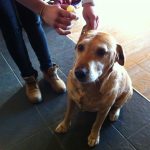The Hazards of Grass Seeds.
Now that summer has finally arrived, we can enjoy walking our dogs in the glorious sunshine out in the country. However, it is important to be aware of areas of the countryside which could pose a hazard to our dogs. Read our Holidays4Dogs article for more information.
One particular risk is that of grass seeds, especially barley grass. These are sharp enough to penetrate skin and migrate around the body.
Risks.
It is most common for grass seeds to lodge between the toes, but equally they can get into the ears, nose and eyes causing hay-fever symptoms. They can also cause problems in the external reproductive organs.
but equally they can get into the ears, nose and eyes causing hay-fever symptoms. They can also cause problems in the external reproductive organs.
Seeds between the toes can develop into cysts if not removed and your dog will show signs of discomfort by licking or biting between the toes. Grass seeds lodged in the paw area may also cause the dog to limp.
Likewise, if a seed has become lodged in the ear canal, your dog may shake his head or scratch his ears frantically. Because dogs sniff the ground, seeds easily become lodged in the nasal cavity and can even work their way into the lungs.
Therefore, it is always good practice to check your dog for grass seeds after each walk and preferably avoid areas of long grass or barley crops altogether over the summer season.
What to do if your dog is affected by grass seeds.
Once a seed has become lodged under the dogs’ skin or in the eye (very urgent) or ear, you will need to take your dog to the vet promptly, as it is vital that the seed is removed to prevent further infection. Your vet may also prescribe antibiotics.
To reduce the risk of grass seeds harming your dog there are a number of tips you can consider;
-
Avoid walking your dog through large open areas of long grass, or crops. Although it is fun for dogs to run around in fields and paddocks, it can quickly become a source of misery should the dog pick up a grass seed.
-
Always groom your dog after walking near long grass, especially long-coated breeds. Check between the toes and inside the ears and eyes and also under the tail and “armpits”.
-
If your dog has a heavy coat you may want to consider clipping the long fur from between the toes and around the hocks. Any dog groomer will do this for you if feel you cannot tackle it yourself.
Conclusion.
Finally, make sure you are familiar with the places where you will be walking your dog. Be aware of your local environment and when seeds are likely to be most prevalent. Avoid these areas as far as possible when out with your dog.
There are plenty of less hazardous areas to walk your dog which can still be fun for them. While a dog can look very amusing, or photogenic, bouncing through long grass – there are very real hidden dangers. All our Holidays4Dogs carers are well aware of grass seed danger and will, therefore, minimise contact when guest dogs are staying.


